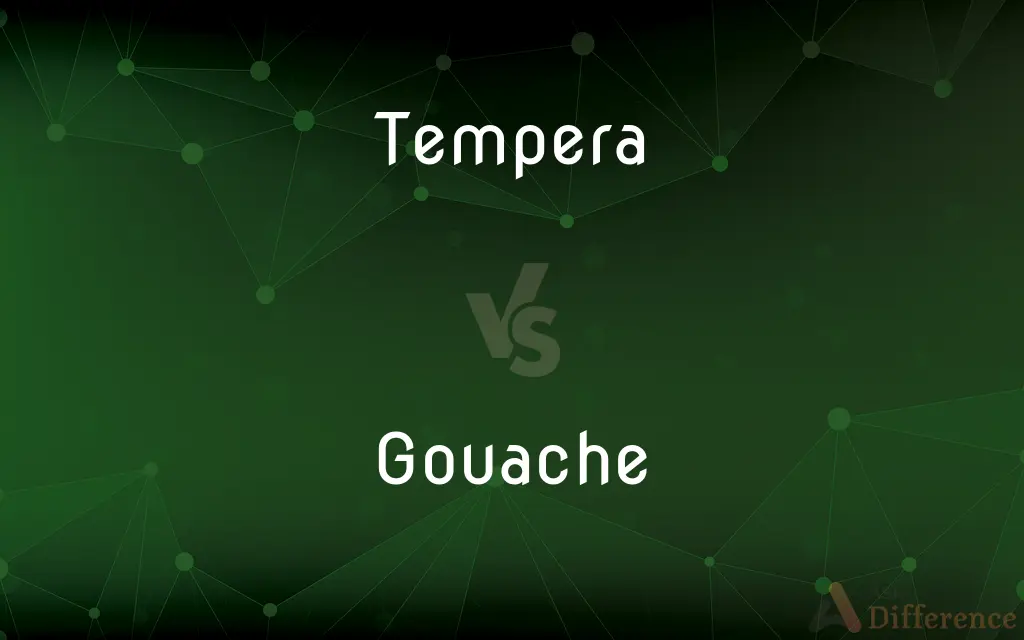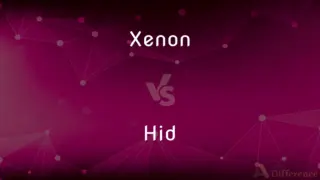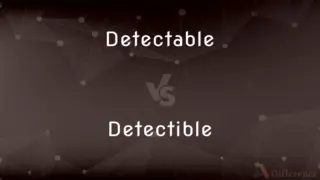Tempera vs. Gouache — What's the Difference?
By Maham Liaqat & Fiza Rafique — Updated on April 21, 2024
Tempera, a fast-drying paint traditionally bound with egg, produces a matte finish and crisp details, while gouache, an opaque watercolor, offers a creamy texture and vibrant colors that dry to a velvety matte look.

Difference Between Tempera and Gouache
Table of Contents
ADVERTISEMENT
Key Differences
Tempera paint is known for its fast-drying quality and the use of egg yolk as a binder, which gives the medium a unique texture and finish. On the other hand, gouache contains a higher pigment concentration and includes a chalk additive, making it heavier and more opaque than other water-based paints.
While tempera is generally applied in thin, semi-transparent layers, building up color gradually to achieve depth and detail, gouache allows for thicker applications and reworking by re-wetting the paint, providing greater flexibility in modifying the artwork after initial application.
The historical use of tempera dates back to ancient times, and it was a predominant medium in early European art until the Renaissance, where it was favored for its precision and permanence. Whereas, gouache became popular in the 18th century among French and English painters for its versatility and ease of use in both fine art and commercial illustrations.
Tempera artworks are typically characterized by their crisp, linear qualities and a matte finish that does not reflect light, making them ideal for detailed illustrative works. Gouache, however, dries to a velvety, matte finish that is slightly reflective and can be used to create smooth gradients of color, popular in modern illustration and design.
Regarding durability, tempera is more vulnerable to environmental factors and can crack or flake over time if not properly cared for, due to the nature of the egg binder. Gouache, while also delicate, is somewhat more flexible and can be better preserved under glass or with protective varnishes.
ADVERTISEMENT
Comparison Chart
Binder
Egg yolk
Gum arabic
Opacity
Semi-transparent to opaque
Opaque
Drying Time
Very fast
Fast
Finish
Matte
Velvety matte
Historical Use
Ancient art, predominantly before the 1500s
Popular since the 18th century
Compare with Definitions
Tempera
A painting medium where pigments are mixed with an egg binder.
The artist used tempera to achieve fine details in his portrait.
Gouache
A type of water-based paint that includes a high pigment load and a chalk additive.
Gouache allows for opaque and matte finishes in art.
Tempera
Often used for its fast-drying properties and matte finish.
Tempera is perfect for works that require multiple layers without reflection.
Gouache
Generally more durable than tempera but still requires careful handling.
Despite its flexibility, gouache artworks are best preserved under protective glass.
Tempera
Requires careful preservation due to its vulnerability to cracking.
The tempera painting had to be kept away from high humidity to prevent damage.
Gouache
Offers smooth gradients and is less reflective than other paints.
Gouache is ideal for creating soft transitions in color.
Tempera
Commonly associated with historical and classical art.
Many medieval manuscripts were illustrated using tempera.
Gouache
Known for its creamy texture and re-workable properties when wet.
The painter adjusted the shadows in his gouache painting by re-wetting the surface.
Tempera
Known for its bright, enduring color quality despite its delicacy.
The tempera on the old fresco remained vibrant after centuries.
Gouache
Popular in both artistic and commercial applications due to its versatility.
Designers often use gouache for vibrant illustrations and posters.
Tempera
Tempera (Italian: [ˈtɛmpera]), also known as egg tempera, is a permanent, fast-drying painting medium consisting of colored pigments mixed with a water-soluble binder medium, usually glutinous material such as egg yolk. Tempera also refers to the paintings done in this medium.
Gouache
Gouache (; French: [ɡwaʃ]), body color, or opaque watercolor, is a water-medium, paint consisting of natural pigment, water, a binding agent (usually gum arabic or dextrin), and sometimes additional inert material. Gouache is designed to be opaque.
Tempera
A painting medium in which pigment is mixed with water-soluble glutinous materials such as size or egg yolk. Also called poster color, poster paint.
Gouache
A method of painting with opaque watercolors mixed with a preparation of gum.
Tempera
Painting done in this medium.
Gouache
An opaque pigment used when painting in this way.
Tempera
A medium used to bind pigments in painting, as well as the associated artistic techniques.
Oil paint
Gouache
A painting executed in this manner.
Tempera
(countable) A painting done in this medium.
Gouache
(painting) A thick, opaque watercolour paint made with gum containing an inert white pigment to make it opaque.
Tempera
A mode or process of painting; distemper.
Gouache
A painting made with this paint.
Tempera
Pigment mixed with water-soluble glutinous materials such as size and egg yolk
Gouache
To produce work in the gouache medium.
Gouache
A method of painting with opaque colors, which have been ground in water and mingled with a preparation of gum; also, a picture thus painted.
Gouache
An opaque watercolor prepared with gum
Gouache
A watercolor executed with opaque watercolors mixed with gum
Common Curiosities
Why is gouache popular in commercial art?
Its vibrant colors and matte finish make gouache ideal for illustrations that need to stand out.
Which medium is older, tempera or gouache?
Tempera is older, with uses tracing back to ancient times.
Can gouache be used on different surfaces?
Yes, gouache can be applied to many surfaces including paper, canvas, and wood.
Is tempera suitable for outdoor paintings?
Due to its sensitivity to the environment, tempera is not ideal for outdoor artworks.
How does gouache achieve its opacity?
Gouache includes a chalk additive to enhance its opacity.
Is gouache easy to learn for beginners?
Yes, gouache is relatively easy to manage and good for beginners in painting.
What is the main binder in tempera paint?
Egg yolk is the traditional binder in tempera.
What are the durability concerns with tempera?
Tempera can crack or flake if exposed to fluctuating environmental conditions.
What is a typical use of tempera in historical art?
Tempera was typically used for religious and iconographic paintings.
Can you rework tempera paint after it has dried?
Tempera is not typically re-workable after drying due to its fast-setting nature.
How does the finish of gouache compare to tempera?
Gouache dries to a velvety matte finish, whereas tempera has a flat matte finish.
What kind of effects can you achieve with gouache?
Gouache is excellent for creating vibrant, opaque layers and smooth gradients.
What is the best way to preserve gouache artworks?
Keeping gouache artworks under glass or with a protective varnish can help preserve them.
How do environmental factors affect gouache paintings?
Like tempera, gouache can suffer if not properly protected but is generally more robust.
Why might an artist choose tempera over other mediums?
An artist might choose tempera for its historical significance and fine detail capabilities.
Share Your Discovery

Previous Comparison
Xenon vs. HID
Next Comparison
Detectable vs. DetectibleAuthor Spotlight
Written by
Maham LiaqatCo-written by
Fiza RafiqueFiza Rafique is a skilled content writer at AskDifference.com, where she meticulously refines and enhances written pieces. Drawing from her vast editorial expertise, Fiza ensures clarity, accuracy, and precision in every article. Passionate about language, she continually seeks to elevate the quality of content for readers worldwide.














































